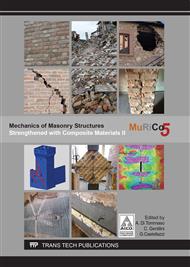p.258
p.266
p.274
p.282
p.289
p.298
p.305
p.313
p.319
Comparison of In-Plane Mechanical Performances of Masonry Walls Strengthened with Different Mortar Coatings Reinforced with Glass or Carbon Fiber Composite Meshes
Abstract:
The results of some diagonal compression tests performed on solid brick masonry samples (1160x1160x250 mm3) to evaluate and compare the effectiveness of different shear reinforcement techniques for existing masonry based of the application, on both sides of the wall, of a mortar coating layer reinforced with fiber composite meshes are presented and discussed in the paper. In particular, 30 mm and 10 mm thick mortar coatings, made of three different mortar types and reinforced by means of both glass and carbon-fibers composite meshes were considered. Significant resistance increases (about 110%) were attained in respect to plain masonry; moreover, it emerged that the meshes are able to prevent the masonry brittle collapse, absorbing tensile stresses in the cracked areas. By maintaining constant the coating thickness, better mortar characteristics determined an increase of the resistance increment ratio but a more rapid decrease of resistance after peak. Similar performances were attained by samples characterized by approximately constant values of shear stiffness and diagonal compression resistance. The differences attributable to the different type of meshes resulted minimal, due to the similar reinforcement percentage.
Info:
Periodical:
Pages:
289-297
Citation:
Online since:
July 2017
Authors:
Price:
Сopyright:
© 2017 Trans Tech Publications Ltd. All Rights Reserved
Share:
Citation:


